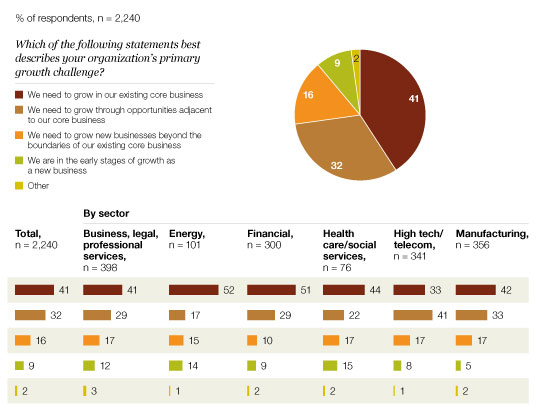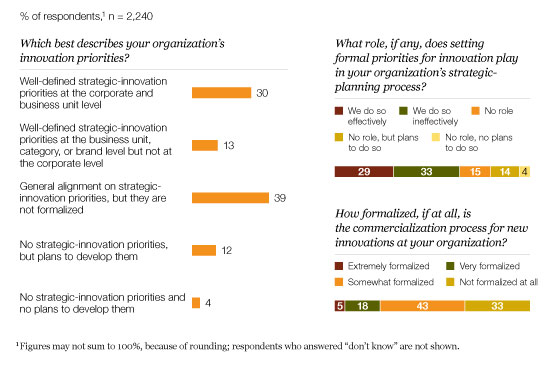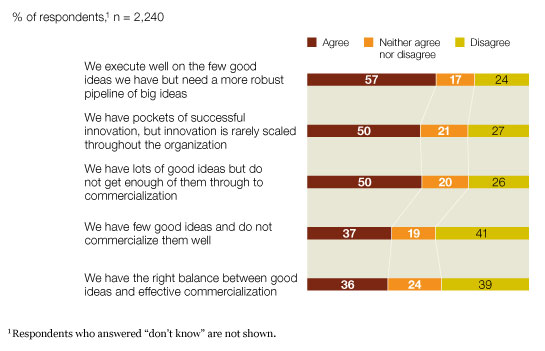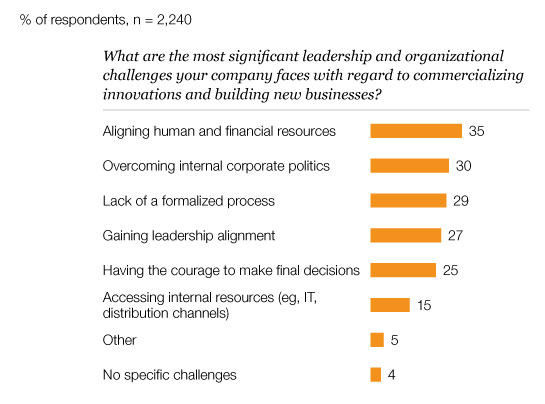As companies begin to refocus on growth, innovation has once again become a priority: in a recent McKinsey Global Survey,1 84 percent of executives say innovation is extremely or very important to their companies’ growth strategy. The results also show that the approach companies use to generate good ideas and turn them into products and services has changed little since before the crisis, and not because executives thought what they were doing worked perfectly. Further, many of the challenges—finding the right talent, encouraging collaboration and risk taking, organizing the innovation process from beginning to end—are remarkably consistent. Indeed, surveys over the past few years suggest that the core barriers to successful innovation haven’t changed, and companies have made little progress in surmounting them.
More positively, the results also suggest some ways that companies can become more successful at innovation. In particular, they can formalize processes for setting priorities and commercializing products and integrate innovation into their strategic-planning efforts.
Growth and innovation
Almost all companies are actively seeking growth again. For the largest group of respondents, 41 percent, the focus is on their existing core businesses (Exhibit 1). Only respondents in the high-tech industry differ. In addition, more executives say their companies are seeking organic growth through new products or services or new customers in existing markets (68 percent and 63 percent, respectively) than are pursuing growth through new markets or M&A.
Innovation is important across growth strategies. However, a slightly smaller share of executives at companies seeking growth in their core business, 80 percent, say innovation is very or extremely important, compared with 91 percent of those at companies still in the early stages of expansion.
The primary growth challenge

Managing innovation
Just over half of all respondents, 55 percent, say their companies are better than their peers at innovation, a figure that hasn’t budged since 2008. Another consistent pattern is that far fewer respondents say their companies are good at the specific processes and tactics frequently tied to successful innovation—such as generating breakthrough ideas, selecting the right ideas, prototyping, and developing business cases. Respondents say their companies are best at adapting once they’re in the market, with 58 percent claiming to be successful. As in the past, executives have the most difficulty stopping ideas at the right time, with only 26 percent of respondents to this survey saying they do this well.
Fundamentally, the biggest challenge is organization: 42 percent of respondents say improvement in this area alone would make the most profound difference in innovation performance. This figure falls between the shares of respondents to a 2007 survey who selected allocating resources and aligning talent as their companies’ top challenges to successful innovation.2 For this year’s respondents, organization is closely followed in importance by developing a climate that fosters innovation; commercializing new businesses, products, or services; and selecting the right ideas and managing a portfolio.
Respondents also indicate that their companies don’t make good use of many specific tactics (Exhibit 2). For example, only 27 percent say their companies are very or extremely effective at making business leaders formally accountable for innovation. Notably, even among respondents at early-growth companies, where innovation is likely to be a particularly high priority, only 34 percent say their business leaders are effectively held accountable.3
Nearly a third of the current survey’s respondents say their companies are effective in setting formal priorities for innovation during the strategic-planning process (Exhibit 3). This result is slightly better than related findings from 2007, when roughly a quarter of respondents said their companies included innovation as a formal part of their strategic-planning process, and from 2008, when just under 20 percent said their innovation processes as a whole were very or extremely formalized.4
Respondents at companies that set formal priorities for innovation as part of the planning process are much likelier to say their companies are better at innovation than their peers (63 percent of those who prioritize versus 43 percent of others) and to say their companies are using these tactics effectively. The survey results suggest that simply ensuring innovation is tightly managed can boost performance.
Innovation tactics

Informal innovation

Going to market
Only 39 percent of respondents say their companies are good at commercializing new products or services. This overall assessment seems to have a few different sources (Exhibit 4). Commercialization was a serious concern in 2007 as well; in that year’s survey, nearly a third of senior leaders selected making handoffs from ideas to commercialization as one of their biggest challenges, and 43 percent said the top challenges included choosing which ideas to move forward.
A big part of the problem may be the absence of a formal decision-making process: 40 percent of respondents say their companies make commercialization decisions in an ad hoc manner; only 23 percent say such decisions are a regular agenda topic at corporate-leadership meetings. Thirty-three percent say these decisions are made at the business unit or functional level. Not surprisingly, the aspects of decision making that executives personally find most difficult are the lack of a fact base and the level of uncertainty—the same as in 2007.
The responses indicate that a lack of formal organization is a common problem: more executives chose the absence of a formal process to align the necessary internal resources as the top commercialization challenge, although those at companies with a formal process for commercialization—23 percent of all respondents—say execution is the biggest challenge (Exhibit 5).
Further, whether they say their companies are good or poor at commercialization, respondents highlight two of the same reasons for their performance, and both relate to organization: the relationship between R&D and marketing and the process for translating an idea into a prototype. Those at companies that are poor at commercialization also frequently blame ineffective processes for manufacturing or rolling out innovations. And among all respondents, aligning human and financial resources is the most frequently cited leadership or organizational challenge to successful commercialization (Exhibit 6).
Formality clearly makes a difference: the share of executives saying their companies are good at commercialization rises to 45 percent among those that set formal strategic priorities for innovation, and to 56 percent among the respondents at companies with a very or extremely formalized process for commercializing innovations.
Making organizational changes can be difficult,5 however, and most companies have focused on other areas to improve their performance. Forty-four percent of respondents, for example, say their companies have tried partnering more successfully with suppliers and technology firms, with 39 percent having integrated customer insights into the process.
Assessing innovation

Formalization’s impact

Challenges to commercialization

Looking ahead
Executives at companies that set formal priorities for innovation rate their overall success higher than others and are more likely to say they’re good at a number of tactics tied to success. These results suggest that other companies would benefit from the simple step of setting formal strategic-innovation priorities.
Organizational factors, including innovation-specific processes and links to support functions, remain a challenge. As hard as it is for companies to implement organizational changes in increasingly complex environments, the results suggest that when companies make the effort, they will experience more success with innovation.
To improve commercialization, it seems to be crucial to build good relationships among all the functions involved directly (such as R&D) or in support roles (such as IT). Nevertheless, most companies still haven’t tried doing so.

